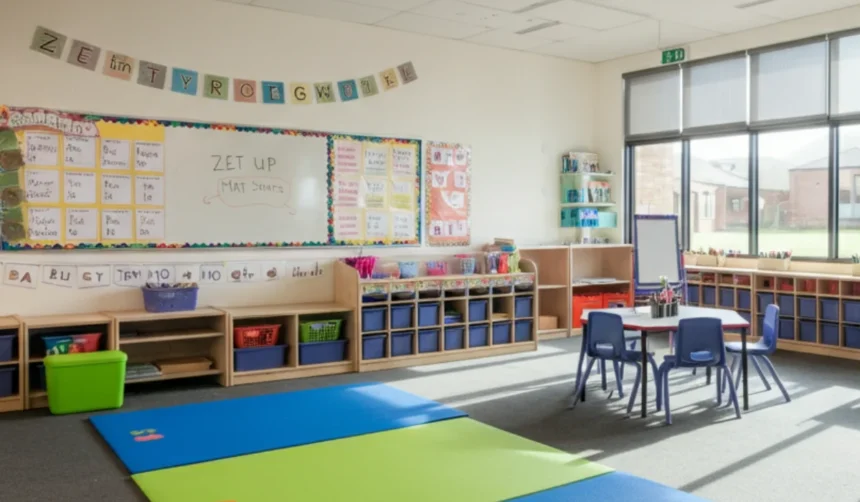Introduction to Zet Up Mat Classroom
Imagine walking into a classroom that feels less like a traditional learning space and more like an interactive hub of creativity and collaboration. This is the essence of a Zet Up Mat Classroom—a dynamic environment where students thrive, ideas flourish, and learning becomes an exciting adventure. With flexible seating arrangements, vibrant colors, and resources at their fingertips, students can engage in hands-on activities while developing critical skills needed for the future.
Creating such an inspiring atmosphere doesn’t just happen by chance; it requires thoughtful planning and design. In this guide, we’ll explore what makes a Zet Up Mat Classroom unique and how you can transform your own teaching space into one that ignites curiosity and fosters effective learning experiences. Are you ready to elevate your classroom? Let’s dive in!
The Importance of a Well-Designed Classroom
A well-designed classroom serves as the foundation for effective learning. It goes beyond mere aesthetics; it influences student engagement, motivation, and overall academic performance.
When students enter a space that feels organized and inviting, they are more likely to feel at ease. Comfort fosters focus. In an environment where materials are easily accessible and layouts promote interaction, collaboration flourishes.
Moreover, thoughtful design caters to diverse learning styles. Flexible seating arrangements allow for different group dynamics while accommodating individual preferences. This adaptability helps every student find their niche.
Lighting also plays a crucial role in creating the right atmosphere. Natural light can uplift spirits and boost concentration levels significantly.
Investing time into designing your classroom enhances not only its functionality but also its potential to inspire young minds daily. Each element contributes to a holistic approach that nurtures both academic growth and emotional wellbeing.
The Benefits of a “Zet Up Mat Classroom”
A “Zet Up Mat Classroom” transforms the traditional learning environment. This innovative layout fosters collaboration among students, encouraging them to work together and exchange ideas freely.
Enhanced engagement is another significant advantage. The flexible use of mats allows for various seating arrangements, making lessons more dynamic and interactive. Students can easily transition between group activities and individual tasks.
Moreover, this setup promotes physical comfort. Soft mats relieve pressure during long study sessions, helping students maintain focus without discomfort or distraction.
Creativity flourishes in a Zet Up Mat Classroom. The open space invites imaginative thinking, allowing learners to explore concepts hands-on while instilling a sense of ownership over their surroundings.
It nurtures independence as students learn to navigate their space effectively. They develop responsibility by organizing materials and choosing where they want to work based on personal preferences.
Step-by-Step Guide to Creating a
Creating a Zet Up Mat Classroom starts with assessing your space. Measure the room to understand how you can best utilize each area for learning.
Next, choose versatile mats that suit various activities. Look for durable options that provide comfort and safety.
Designate specific zones within the classroom. Consider areas for group work, quiet reading, and hands-on projects. This helps students move fluidly between tasks without disruption.
Incorporating flexible furniture is vital. Lightweight tables and chairs should easily adapt to different configurations based on daily needs.
Keep aesthetics in mind. Use bright colors and engaging visuals to inspire creativity while ensuring the layout promotes focus and collaboration among students.
Incorporating Technology and Hands-On Learning in the Design
Incorporating technology into a Zet Up Mat Classroom can significantly enhance the learning experience. Interactive whiteboards, tablets, and educational apps open new avenues for engagement. Students can collaborate on projects using digital tools, promoting teamwork.
Hands-on learning is equally vital. When students manipulate objects or experiment with materials, they grasp concepts more firmly. Incorporate flexible seating arrangements that allow movement and encourage exploration.
Consider integrating virtual reality experiences to immerse students in different environments or historical contexts. This approach makes lessons memorable and encourages curiosity.
Additionally, create designated areas for tech-based activities alongside tactile resources like art supplies or science kits. Striking this balance fosters a comprehensive learning environment where both digital literacy and practical skills flourish.
Tips for Maintaining an Organized and Functional Space
Keeping a “Zet Up Mat Classroom” organized is key to fostering an engaging learning environment. Start by designating specific areas for different activities. Use color-coded mats or zones to visually indicate spaces for reading, group work, or quiet reflection.
Regularly involve students in organizing the classroom. Assign them roles like “mat monitors” who ensure the area remains tidy and arranged properly after each use. This not only encourages responsibility but also promotes teamwork.
Utilize storage solutions that are easily accessible yet out of sight. Bins, shelves, and drawers can help keep supplies at hand while reducing clutter on surfaces.
Establish a routine for daily clean-ups. A few minutes at the end of each lesson can make a huge difference in maintaining order and functionality throughout the school day.
Success Stories from Teachers Who Have Implemented the
Teachers across various schools have shared inspiring stories about their experiences with the zet up mat classroom. One third-grade teacher transformed her traditional room into a flexible, collaborative space. Students thrived as they engaged in group projects while sitting on colorful mats.
Another educator introduced the concept during math lessons. The hands-on approach allowed students to physically manipulate materials. This tactile experience made challenging concepts more accessible and enjoyable.
A high school science teacher reported increased participation after implementing the zet up mat layout. Students felt empowered to share ideas in small groups, fostering a sense of community within the class.
These success stories highlight how a thoughtfully designed learning environment can ignite curiosity and enhance student engagement across grade levels. Educators are finding that when students feel comfortable and inspired, their potential truly shines.
Conclusion: Empowering Students Through a Thoughtfully Designed Learning Environment
Creating a “Zet Up Mat Classroom” is more than just setting up desks and chairs. It’s about fostering an environment that promotes engagement, collaboration, and creativity among students. By thoughtfully designing your classroom space to prioritize flexibility and comfort, you empower learners to take ownership of their education.
A well-structured Zet Up Mat Classroom can accommodate various learning styles. The incorporation of technology alongside hands-on activities further enriches the experience for every student. When learners feel comfortable in their surroundings, they are more likely to participate actively and succeed academically.
Teachers who have embraced this innovative classroom design often share inspiring stories of transformation. Students become more engaged when they have the freedom to explore different setups during lessons or collaborate with peers without rigid constraints.
By continually maintaining organization within the space, educators can ensure that it remains conducive to learning over time. A dynamic classroom allows for adjustments based on curricular needs or student feedback.
Investing in a Zet Up Mat Classroom creates not just a physical space but also nurtures positive relationships among students and teachers alike—a vital component in today’s educational landscape where adaptability is key.











